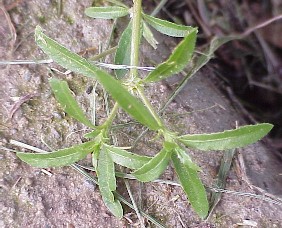|
Scientific name: Alternanthera denticulata R.Br.Common name: Lesser joyweedFamily: AmaranthaceaeOrigin:Native of Australia. Habit:Small, perennial herb with prostrate stems. Habitat:A native species that is considered a weed of damp or swampy ground. General description:Stems and leavesThe nodes of the stems can be hairless or softly hairy. The internodes at the tips of the stems are sparsely hairy. Leaves are paired (oppositely arranged) with short stalks (petioles) 1-4 mm long. They are narrow (linear-obovate to narrowly elliptic) and 7-90 mm × 2-10 mm in size. Leaf margins are most often finely toothed or sometimes entire. Flowers and fruitFlowers are small and borne on short spikes clustered in the leaf axils. These clusters are 3-6 mm in diameter. 'Petals' (perianth segments) are whitish, 1.5-3 mm long, hairless, and resemble scales or bracts. The tiny fruit (< 2 mm in size) are rounded with a notch at the tip. Flowering occurs from spring to autumn. Distinguishing characteristics:A small perennial herb with many branching prostrate stems. It has paired narrow leaves and is sparsely hairy or hairless. Inflorescences are small clusters of whitish flowers at the leaf bases (ie. in the leaf axils). Alternanthera denticulata (lesser joyweed) is quite similar to Alternanthera nana (hairy joyweed), except for the presence of many hairs on the leaves and stems of this species. Also, the leaves of Alternanthera denticulata (lesser joyweed) are more elongated (ie. almost linear) than those of Alternanthera nana (hairy joyweed). Another slightly similar species is Alternanthera pungens (khaki weed), however it can be distinguished by the presence of sharp prickles during flowering. Noxious status:Not noxious. Sources:Stanley, T.E. and Ross, E.M. (1983-1989). Flora of South-eastern Queensland. Volume 1. Department of Primary Industries, Brisbane. |

